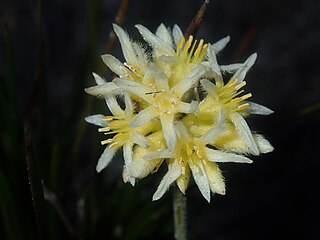
Conostylis setigera, commonly known as bristly cottonhead, is a rhizomatous, tufted perennial, grass-like plant or herb in the family Haemodoraceae and is endemic to the south-west of Western Australia.
Conostylis wonganensis, known as Wongan conostylis, is a rhizomatous, tufted, perennial grass-like plant or herb in the family Haemodoraceae and is an endemic of Southwest Australia. It has glabrous leaves and creamy-yellow, tubular flowers.

Conostylis caricina is a flowering plant in the family Haemodoraceae and is endemic to the south-west of Western Australia. It is a rhizomatous, tufted perennial, grass-like plant or herb with flat leaves and heads of 6 to 8 creamy-yellow flowers.

Conostylis crassinerva is a rhizomatous, tufted perennial, grass-like plant or herb in the family Haemodoraceae and is endemic to the south-west of Western Australia. It has flat leaves and yellow tubular flowers that turn reddish as they age.
Conostylis latens is a rhizomatous, tufted perennial, grass-like plant or herb in the family Haemodoraceae and is endemic to the south-west of Western Australia. It has flat, green, usually hairy leaves, and greenish-yellow, tubular flowers.
Conostylis lepidospermoides, commonly known as sedge conostylis, is a rhizomatous, tufted perennial, grass-like plant or herb in the family Haemodoraceae and is endemic to the south-west of Western Australia. It has flat, yellowish-green, glabrous leaves, and lemon-yellow, tubular flowers.
Conostylis micrantha, commonly known as small-flowered conostylis, is a rhizomatous, tufted perennial, grass-like plant or herb in the family Haemodoraceae and is endemic to the south-west of Western Australia. It has leaves that are round in cross-section and have bristles or hairs on the lower edges, and pale yellowish cream, tubular flowers.
Conostylis pauciflora, commonly known as Dawesville conostylis, is a rhizomatous, stoloniferous, perennial, grass-like plant or herb in the family Haemodoraceae and is endemic to the south-west of Western Australia. It has flat, green leaves with bristles on the edges, and relatively few tubular flowers.
Conostylis petrophiloides is a rhizomatous, tufted perennial, grass-like plant or herb in the family Haemodoraceae and is endemic to the south-west of Western Australia. It has flat, glabrous leaves, and yellowish-cream coloured, tubular flowers.

Conostylis prolifera, commonly known as mat cottonheads, is a rhizomatous, tufted, stoloniferous, perennial, grass-like plant or herb in the family Haemodoraceae and is endemic to the south-west of Western Australia. It has flat, glabrous leaves, and yellow and cream-coloured, tubular flowers.
Conostylis resinosa is a rhizomatous, tufted perennial, grass-like plant or herb in the family Haemodoraceae and is endemic to the south-west of Western Australia. It has flat, shiny leaves, yellow, tubular flowers and is similar to C. aurea.

Conostylis robusta is a rhizomatous, tufted, stoloniferous, perennial, grass-like plant or herb in the family Haemodoraceae and is endemic to the south-west of Western Australia. It has flat, green leaves with bristles on the edges, and heads of yellow flowers on a relatively long flowering stem.
Conostylis rogeri is a rhizomatous, tufted perennial, grass-like plant or herb in the family Haemodoraceae and is endemic to a small area in the south-west of Western Australia. It has small tufts, flat leaves, and a single pale yellow, tubular flower.

Conostylis seminuda is a rhizomatous, tufted perennial, grass-like plant or herb in the family Haemodoraceae and is endemic to a small area in the south-west of Western Australia. It has flat leaves and golden yellow, tubular flowers.

Conostylis seorsiflora is a rhizomatous, tufted perennial, grass-like plant or herb in the family Haemodoraceae and is endemic to the south of Western Australia. It has flat leaves and yellow, tubular flowers.

Conostylis setosa, commonly known as white cottonhead, is a rhizomatous, tufted perennial, grass-like plant or herb in the family Haemodoraceae and is endemic to the south-west of Western Australia. It has flat leaves and white, or pinkish maroon to purple flowers

Conostylis teretifolia is a rhizomatous, tufted, perennial, grass-like plant or herb in the family Haemodoraceae and is endemic to the south-west of Western Australia. It has flat leaves, short stems and yellow to reddish, tube-shaped flowers.

Conostylis teretiuscula is a rhizomatous, tufted perennial, grass-like plant or herb in the family Haemodoraceae and is endemic to the south west of Western Australia. It has flat leaves and yellow, tube-shaped flowers.
Conostylis tomentosa is a rhizomatous, tufted perennial, grass-like plant or herb in the family Haemodoraceae and is endemic to the south-west of Western Australia. It has flat leaves with bristles of hairs on the leaf margins, and golden yellow, tubular flowers.
Conostylis villosa is a rhizomatous, tufted perennial, greyish-green, grass-like plant or herb in the family Haemodoraceae and is endemic to the south west of Western Australia. It has flat leaves and yellow flowers aging purplish-red.











